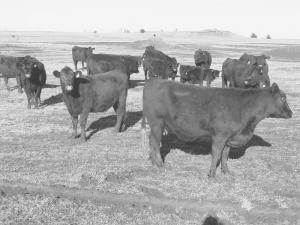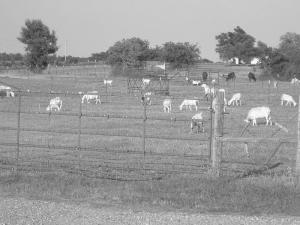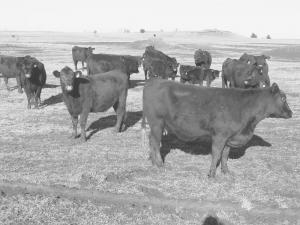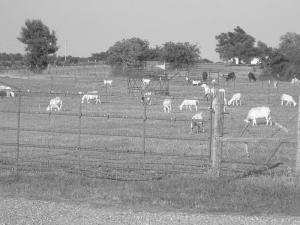"Dual Purpose" Red Poll Cattle Back In Demand
Demand is growing for a very old beef breed that's ideal for producing grass-fed meat, says Nathan Melson, Dodd City, Texas. The former purebred Angus breeder now has a small herd of registered Red Polls and says he has lots of calls for heifers. He redirects calls to other breeders as he is still building his herd.
"I have had more calls on the Red Polls in three years than I had on the Angus in 10," says Melson.
Even with good quality Angus, Melson had found it hard as a small breeder to sell seed stock. Having already switched to an intensive grazing system, he sold his Angus and went looking for a lower maintenance breed.
"I started looking at heritage breeds, feeling they hadn't been played with as much," says Melson. "I wanted a good milker with a good calf weaned on grass. Tenderness was important, too."
After looking at milking shorthorns, Murray Gray, Devon and Dexter, Melson turned to Red Poll, a dual-purpose dairy/beef breed first introduced to North America in 1883. Red Poll cows average around 1,300 lbs. He was attracted by their large loin eyes, pelvic areas, wide pin bones and larger rumen capacity.
Melson bought part of a breeder's herd and, after three years, is nearing his goal of 45 cows. He wants to reach a point where he can sell seed stock and direct market meat.
"Red Polls have high yield carcasses plus tenderness," says Melson. "I can get a 1,100-lb. animal in 18 to 24 months, but can also slaughter some as early as 6 to 8 months for baby beef buyers. They fatten up well on mother's milk."
Melson's weaned calves are kept on grass with some supplemental hay and alfalfa pellets as needed. He also uses a mineral mix with sea kelp he designed himself. Medications are kept to a minimum, and no implants are used.
"I am pushing toward the non-certified organic market," says Melson. "In Texas, certification is expensive. It would cost $1,500 to $2,000 to get and maintain certification. I think it is more important to sell local and let people see how you manage."
He is already building a market for his meat, selling steers on the hoof to a growing list of satisfied customers. The list is growing to the point that Melson is planning to build a barn with coolers so he can sell by the cut. "I can just about triple my gross per animal that way," he explains.
Melson also raises and sells St. Croix Hair sheep and grainless Myotonic goats, both heritage breeds themselves. He is experimenting with a multi-species grazing system. His goal is to replicate the natural prairie system to utilize all the vegetation and replace brush control with animals. In his system, the Red Polls take the place of grass-eating buffalo. Sheep take the place of elk, eating broadleaves and grass. Goats mimic deer as browsers, grazing a lot of broadleaf and brush species.
"When you pull the species together, goats and sheep compete some, but each will eat weeds the other won't," says Melson. "Neither competes with cows as long as you manage the stocking rates."
So far he has about 32 acres of 5 to 10- acre paddocks dedicated to multi-species grazing. His goal is to have 132 acres fenced for the program.
"They manage the weeds really well," says Melson. "The multi-species pastures are as thick with grass and low on weeds as ones with just cattle, which we have to shred and clip to keep weeds down and manage maturity."
A final avenue Melson is exploring is to manage part of his herd as a raw milk dairy. Texas is one of the few states where milk can be sold unpasteurized.
"In England, the Red Poll average production averages 10,000 lbs. per lactation with quality nearly as good as Jerseys," says Melson. "I am going to set up a barn with stanchions for some cows and get certified for raw milk."
Contact: FARM SHOW Followup, Nathan Melson, Sloans Creek Farm, 3385 E. Hwy. 56, Dodd City, Texas 75438 (ph 903 583-4951; sloanscreekfarm@juno.com; http://homepage.mac.com/nbmelson/) or American Red Poll Association, P.O. Box 147, Bethany, Mo. 64424 (ph 660 425-7318; fax 660 425-8374; info@redpollusa.org; www.redpoll usa.org).

Click here to download page story appeared in.
Click here to read entire issue
"Dual Purpose" Red Poll Cattle Back In Demand AG WORLD 29-5-24 Demand is growing for a very old beef breed that's ideal for producing grass-fed meat, says Nathan Melson, Dodd City, Texas. The former purebred Angus breeder now has a small herd of registered Red Polls and says he has lots of calls for heifers. He redirects calls to other breeders as he is still building his herd.
"I have had more calls on the Red Polls in three years than I had on the Angus in 10," says Melson.
Even with good quality Angus, Melson had found it hard as a small breeder to sell seed stock. Having already switched to an intensive grazing system, he sold his Angus and went looking for a lower maintenance breed.
"I started looking at heritage breeds, feeling they hadn't been played with as much," says Melson. "I wanted a good milker with a good calf weaned on grass. Tenderness was important, too."
After looking at milking shorthorns, Murray Gray, Devon and Dexter, Melson turned to Red Poll, a dual-purpose dairy/beef breed first introduced to North America in 1883. Red Poll cows average around 1,300 lbs. He was attracted by their large loin eyes, pelvic areas, wide pin bones and larger rumen capacity.
Melson bought part of a breeder's herd and, after three years, is nearing his goal of 45 cows. He wants to reach a point where he can sell seed stock and direct market meat.
"Red Polls have high yield carcasses plus tenderness," says Melson. "I can get a 1,100-lb. animal in 18 to 24 months, but can also slaughter some as early as 6 to 8 months for baby beef buyers. They fatten up well on mother's milk."
Melson's weaned calves are kept on grass with some supplemental hay and alfalfa pellets as needed. He also uses a mineral mix with sea kelp he designed himself. Medications are kept to a minimum, and no implants are used.
"I am pushing toward the non-certified organic market," says Melson. "In Texas, certification is expensive. It would cost $1,500 to $2,000 to get and maintain certification. I think it is more important to sell local and let people see how you manage."
He is already building a market for his meat, selling steers on the hoof to a growing list of satisfied customers. The list is growing to the point that Melson is planning to build a barn with coolers so he can sell by the cut. "I can just about triple my gross per animal that way," he explains.
Melson also raises and sells St. Croix Hair sheep and grainless Myotonic goats, both heritage breeds themselves. He is experimenting with a multi-species grazing system. His goal is to replicate the natural prairie system to utilize all the vegetation and replace brush control with animals. In his system, the Red Polls take the place of grass-eating buffalo. Sheep take the place of elk, eating broadleaves and grass. Goats mimic deer as browsers, grazing a lot of broadleaf and brush species.
"When you pull the species together, goats and sheep compete some, but each will eat weeds the other won't," says Melson. "Neither competes with cows as long as you manage the stocking rates."
So far he has about 32 acres of 5 to 10- acre paddocks dedicated to multi-species grazing. His goal is to have 132 acres fenced for the program.
"They manage the weeds really well," says Melson. "The multi-species pastures are as thick with grass and low on weeds as ones with just cattle, which we have to shred and clip to keep weeds down and manage maturity."
A final avenue Melson is exploring is to manage part of his herd as a raw milk dairy. Texas is one of the few states where milk can be sold unpasteurized.
"In England, the Red Poll average production averages 10,000 lbs. per lactation with quality nearly as good as Jerseys," says Melson. "I am going to set up a barn with stanchions for some cows and get certified for raw milk."
Contact: FARM SHOW Followup, Nathan Melson, Sloans Creek Farm, 3385 E. Hwy. 56, Dodd City, Texas 75438 (ph 903 583-4951; sloanscreekfarm@juno.com; http://homepage.mac.com/nbmelson/) or American Red Poll Association, P.O. Box 147, Bethany, Mo. 64424 (ph 660 425-7318;
To read the rest of this story, download this issue below or click
here to register with your account number.










